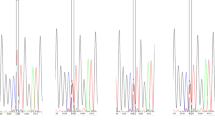Abstract
Objective
To identify the genetic cause of transient neonatal diabetes mellitus in three siblings from an Indian family.
Methods
Case reports with clinical and molecular evaluation of an activating mutation in the KCNJ11 gene are presented. We describe an Indian family with two asymptomatic parents with 3 children presenting with hyperglycemia at 6, 1.5 and 1 month of age respectively. Blood glucose levels at presentation were 22.2, 18.3 and 20 mmol/L and the diabetes remitted in all three children by 5 years of age. None of the affected siblings had dysmorphism or neurological abnormalities. Diabetes relapsed in the oldest sibling at 9.4 years of age and she is now euglycemic on 1mg/Kg of Glibenclamide twice a day.
Results
A novel heterozygous missense mutation (G53V) in the KCNJ11 gene was identified in all 3 affected children and the father.
Conclusions
Our report suggests that screening for KCNJ11 mutations is appropriate in patients diagnosed with neonatal diabetes as it provides valuable information concerning possible course of the disease and choice of treatment.
Similar content being viewed by others
References
Hattersley AT, Ashcroft FM. Activating mutations in Kir6.2 and neonatal diabetes: new clinical syndromes, new scientific insights, and new therapy. Diabetes 2005;54:2503–2513.
Gloyn AL, Pearson ER, Antcliff JF, Proks P, Bruining GJ, Slingerland AS et al. Activating mutations in the gene encoding the ATP-sensitive potassium-channel subunit Kir6.2 and permanent neonatal diabetes. N Engl J Med 2004;350:1838–1849.
Flanagan SE, Edghill EL, Gloyn AL, Ellard S, Hattersley AT. Mutations in KCNJ11, which encodes Kir6.2, are a common cause of diabetes diagnosed in the first 6 months of life, with the phenotype determined by genotype. Diabetologia 2006;49:1190–1197.
Flanagan SE, Patch AM, Mackay DJ, Edghill EL, Gloyn AL, Robinson D et al. Mutations in ATP-sensitive K+ channel genes cause transient neonatal diabetes and permanent diabetes in childhood or adulthood. Diabetes 2007;56:1930–1937.
Gloyn AL, Reimann F, Girard C, Edghill EL, Proks P, Pearson ER et al. Relapsing diabetes can result from moderately activating mutations in KCNJ11. Hum Mol Genet 2005;14:925–934.
Sagen JV, Raeder H, Hathout E, Shehadeh N, Gudmundsson K, Baevre H et al. Permanent neonatal diabetes due to mutations in KCNJ11 encoding Kir6.2: patient characteristics and initial response to sulfonylurea therapy. Diabetes 2004;53:2713–2718.
Proks P, Girard C, Haider S, Gloyn AL, Hattersley AT, Sansom SP et al. A gating mutation at the internal mouth of the Kir6.2 pore is associated with DEND syndrome. EMBO Rep 2005;6:470–475.
Pearson ER, Flechtner I, Njølstad PR et al. Switching from insulin to oral sulfonylureas in patients with diabetes due to Kir6.2 mutations. N Engl J Med 2006;355:467–477.
Vaxillaire M, Populaire C, Busiah K, Cavé H, Gloyn AL, Hattersley AT et al. Kir6.2 mutations are a common cause of permanent neonatal diabetes in a large cohort of French patients. Diabetes 2004;53:2719–2722.
Edghill E, Flanagan S, Patch AM, Boustred C, Parrish, Shields B et al. Insulin Mutation Screening in 1044 Patients with Diabetes: Mutations in the INS gene are a Common Cause of Neonatal Diabetes but a Rarer Cause of Diabetes Diagnosed in Childhood or Adulthood. Diabetes 2008;57:1034–1042.
Ashcroft FM, Rorsman P. Electrophysiology of the pancreatic b-cell. Prog Biophys Mol Biol 1989;54:87–143.
Author information
Authors and Affiliations
Corresponding author
Rights and permissions
About this article
Cite this article
Khadilkar, V.V., Khadilkar, A.V., Kapoor, R.R. et al. KCNJ11 activating mutation in an Indian family with remitting and relapsing diabetes. Indian J Pediatr 77, 551–554 (2010). https://doi.org/10.1007/s12098-010-0062-9
Received:
Accepted:
Published:
Issue Date:
DOI: https://doi.org/10.1007/s12098-010-0062-9




